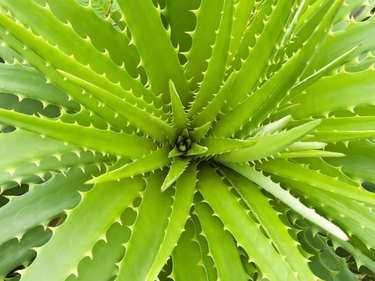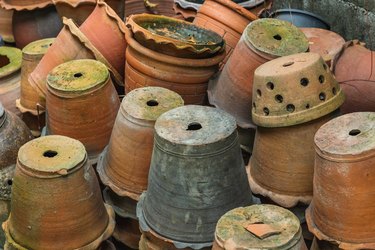
Aloe vera (Aloe vera) plants are among the simplest to propagate from cuttings and divisions--both forms of cloning, or asexual reproduction_._ The plant's succulent, sword-shaped leaves add beauty and structure to yards in U.S. Department of Agriculture plant hardiness zones 10 through 12. You can also grow aloe as a houseplant. Aloe vera plants that result from cloning will perfectly resemble the mother plant, although they may take years to reach full size.
Cutting Versus Dividing
Video of the Day
There are two methods of cloning aloe vera plants. The first is dividing. Like most succulents, aloe vera reproduces naturally through seeds and offsets. Seeds produce independent plants that are not clones and may not look like the parent plant. Offsets, however, are clones. These offsets, called pups, appear around the base of mature aloe vera plants and are attached to the mother by fleshy underground stems, called stolons. To divide aloe, you must cut through these stolons to separate the pup from the mother to produce a clone.
Video of the Day
Cutting is another option for aloe cloning. Just as the name implies, cutting involves snipping off an aloe vera leaf and rooting it to form a clone. Cuttings are a viable way to create cloned plants, but young cuttings are not as attractive as pups, which already boast the prized rosette shape typical of aloe. Pups also mature more quickly than cuttings. Both methods are similar, however, and will produce results.
Cloning Aloe Vera
Division and cutting propagation may seem like two completely different methods of cloning aloe vera, but they have a lot in common. For example, both methods work best in spring and early summer when the plants are actively growing, and both require the same treatments, equipment and procedures.
Step 1
Soak the blade of a utility knife for five minutes in full strength household disinfectant, or in a solution of half rubbing alcohol and half tap water. Rinse the blade after soaking, and wipe it dry.
Step 2
Dig at the base of the aloe vera between a pup and the mother plant to reveal the fleshy stolon, or connecting root. Sever the stolon midway between the two plants with the sanitized blade, and lift the pup from the ground.
Take cuttings from a healthy, plump aloe vera leaf with no signs of trauma or illness. Avoid very thick or wide leaves, because they may not fit in standard pots. Measure back 2 to 4 inches from the tip of the leaf and cut straight through it with the sanitized blade.
Step 3
Place the pup or cutting in an airy, warm area out of direct light. Leave it to dry for a few days, until the cut end is dry, puckered and whitish in color. Do not try to root an aloe vera cutting that hasn't formed this callus.
Step 4

Fill the pot with a mixture of half sand and half potting soil. Saturate the mixture with water, and let the excess drain off before potting. Use a pot with multiple drainage holes around the base. Aloe plants do not like wet feet, so proper drainage is crucial.
Step 5
Scratch a shallow planting hole in the center of the mixture to hold the pup. Nestle the callused end into the hole, then press the mixture gently against the pup to anchor it.
Bury the bottom one-third of the aloe vera cutting in the moistened potting mixture. Press the mixture snugly against it so it stands upright. Make sure the severed end of the cutting is beneath the soil, not the pointed end.
Step 6
Position the potted aloe vera pup or cutting in a bright, warm location out of direct sunlight. Do not water it.
Step 7
Water after a week or so if the growing mixture has dried out to 1 inch beneath the surface. Saturate the mixture, letting the excess drain off completely. Do not let the pot sit in water.
Step 8
Check for roots two weeks after planting, but don't be surprised if cuttings take four to six weeks to root. Tug on the base of the cutting or pup very lightly; if it resists, it has rooted.
Transplanting and Aftercare
Once rooted, aloe vera clones must be transplanted into larger containers to continue their development. Use a draining container that is approximately 1 inch larger than the previous one. A potting mix of equal parts sand and soil will provide the right balance of drainage, nutrients and structure. Repotted aloes should be kept indoors, close to a south-facing window, or outdoors in a sheltered, bright location. They also need:
- Regular watering. Water deeply, but let the soil dry out in the top few inches between waterings.
- Routine feeding. Aloes are moderate feeders under strong light. Feed weekly during the summer with 1/4 teaspoon of 15-15-15 fertilizer mixed into 1 gallon of water. Stop fertilizing in early fall.